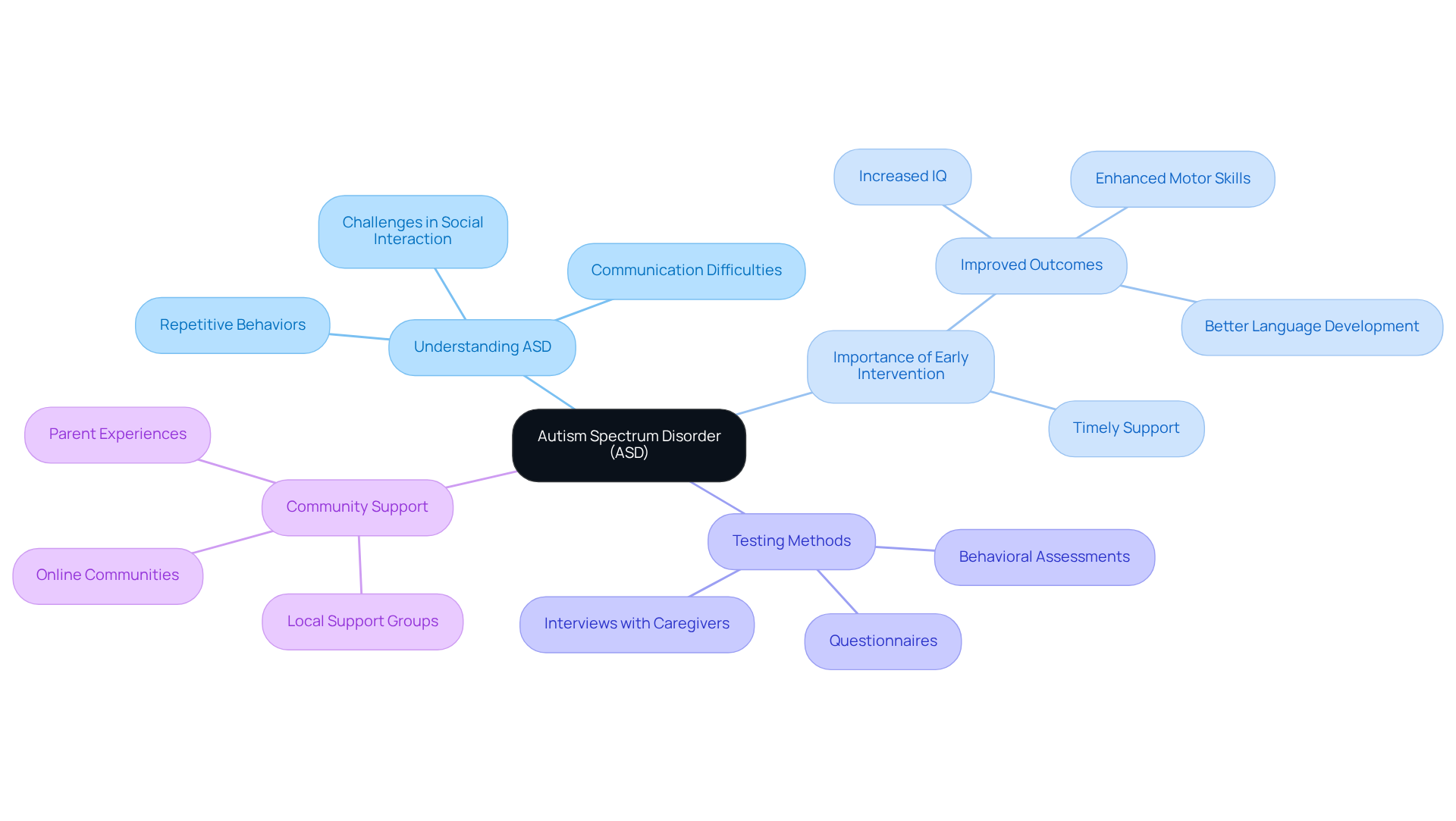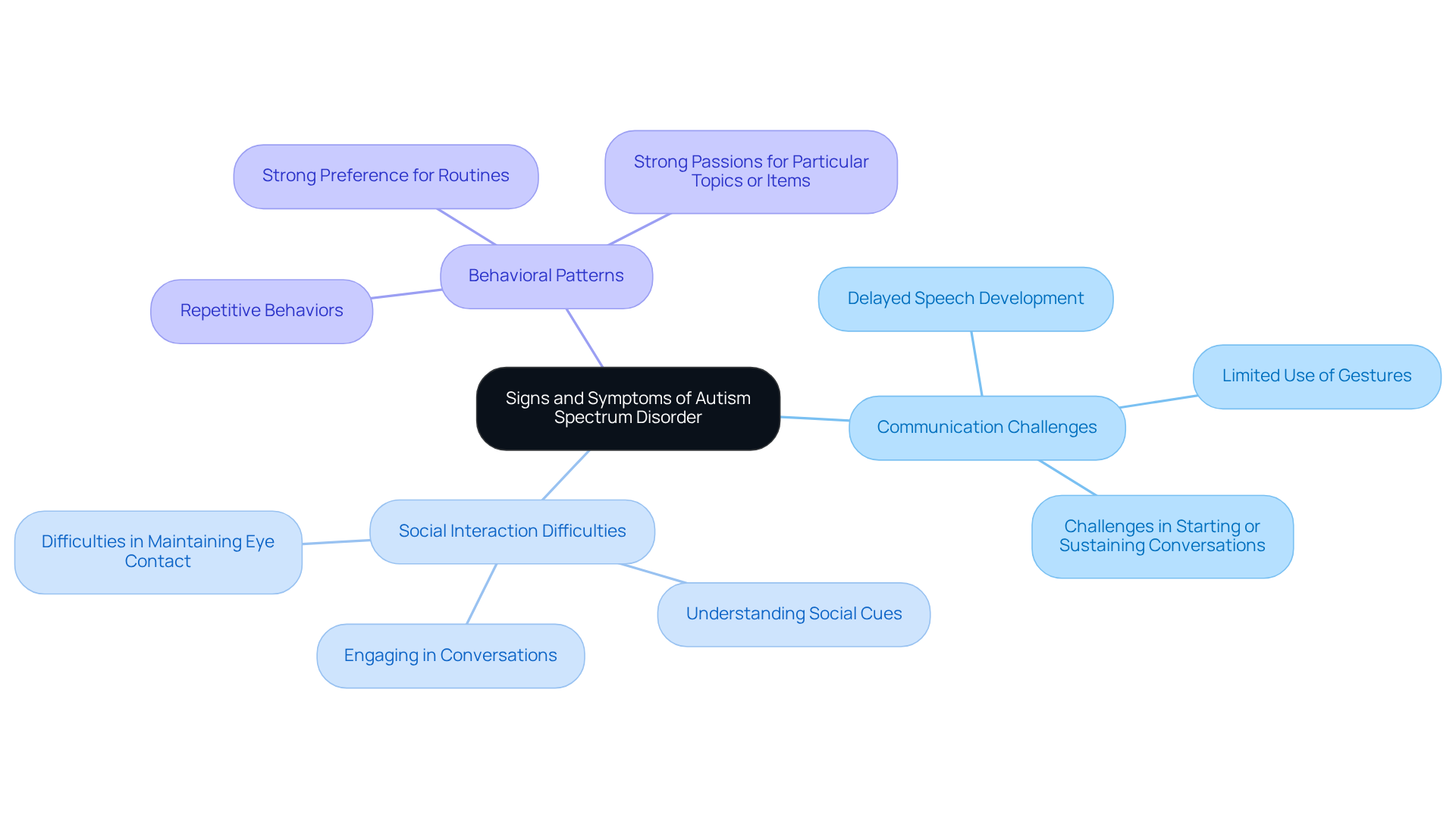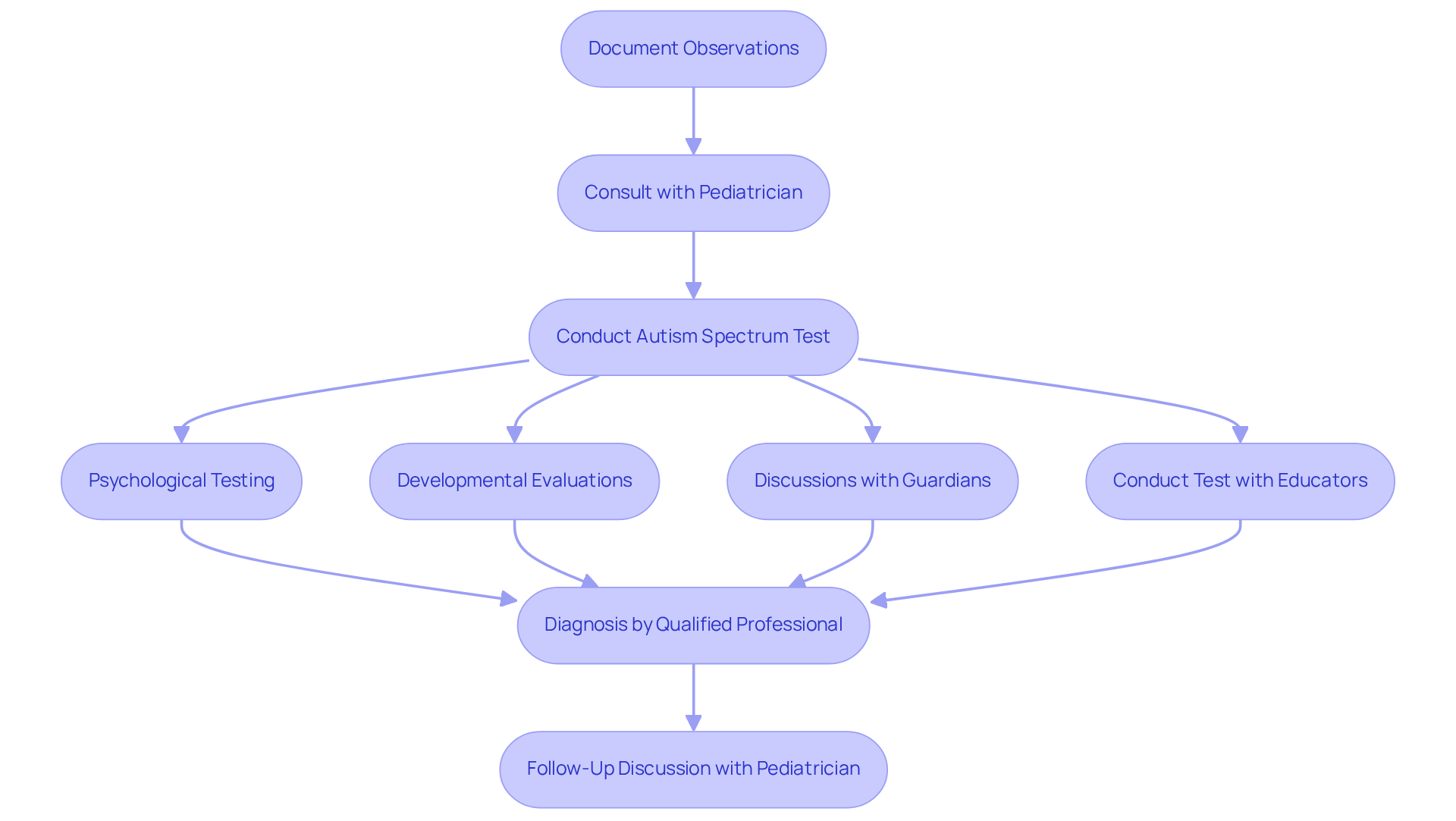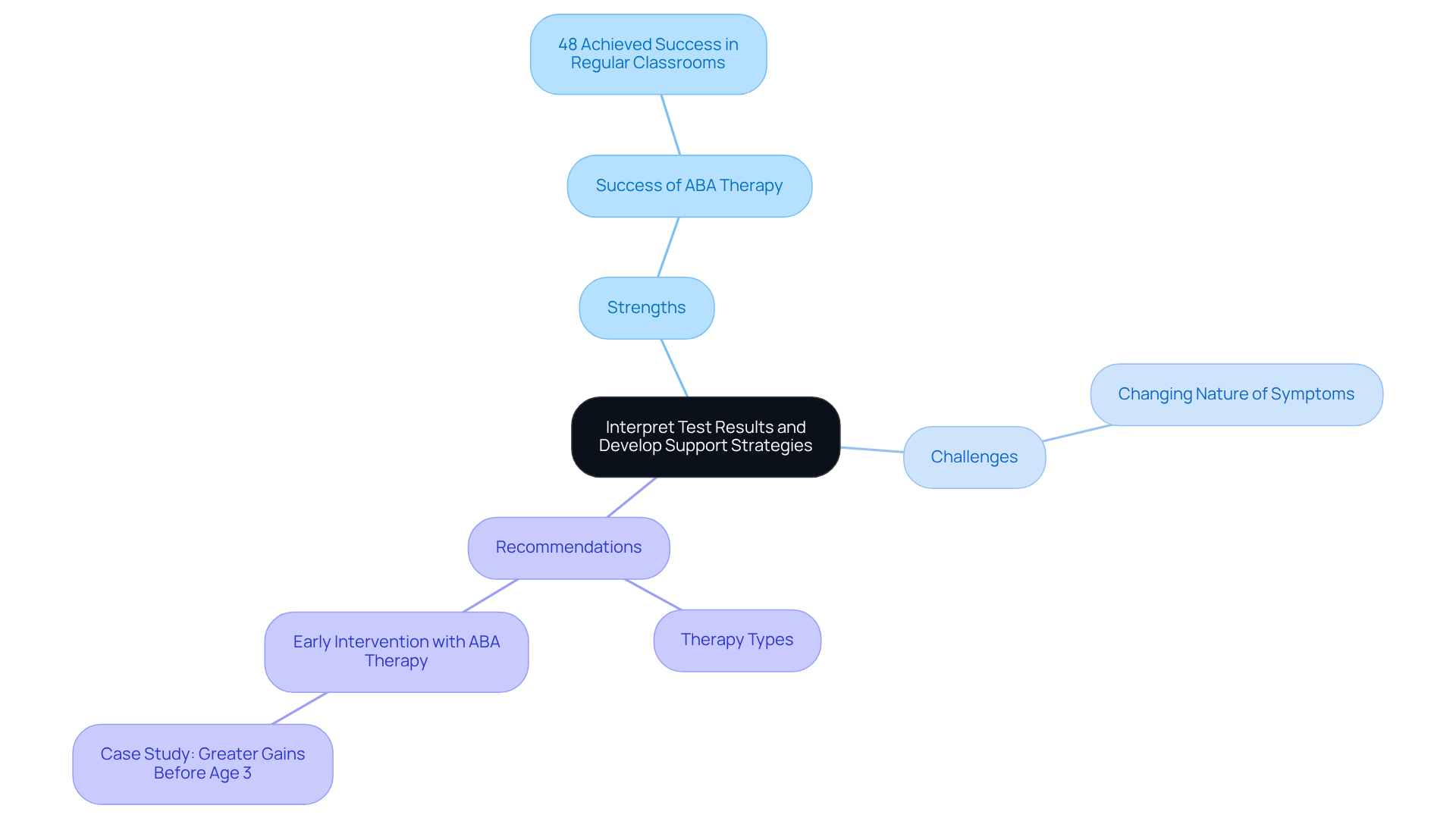Overview
Navigating the autism spectrum test and the diagnosis process for Autism Spectrum Disorder (ASD) can feel overwhelming for parents. This article highlights key steps you can take to support your child during this journey. Early intervention is crucial, and understanding both the strengths and challenges your child faces is essential. By equipping yourself with the right tools and knowledge, you can effectively support your child's development.
As you embark on this path, it's important to recognize that you're not alone. Many parents have walked a similar road, experiencing the same concerns and emotions. The assessment methods outlined here will help you gain clarity and insight into your child's unique needs. Remember, each child is different, and understanding their specific challenges can lead to more tailored support.
Consider sharing your experiences with others in the community. Engaging with fellow parents can provide comfort and valuable perspectives. Additionally, seeking resources and professional guidance will empower you to advocate effectively for your child's needs. Together, we can foster an environment that nurtures growth and development for every child on the spectrum.
Introduction
Understanding Autism Spectrum Disorder (ASD) is essential for parents who wish to support their children through the complexities of diagnosis and intervention. The autism spectrum test acts as a vital tool in identifying developmental challenges, providing insights that can lead to timely and effective interventions. Yet, navigating this process can feel overwhelming.
What steps should parents take to ensure their child receives the necessary support? This article explores the critical stages of understanding, testing, and responding to ASD, empowering parents to make informed decisions for their child's future.
Clarify Autism Spectrum Disorder and the Role of Testing
Autism Spectrum Disorder (ASD) is a developmental disorder that presents unique challenges in social interaction, communication, and repetitive behaviors. Understanding ASD is essential for parents, as it opens the door to early intervention, which can significantly improve outcomes for their children. The autism spectrum test plays a vital role in diagnosing ASD, helping professionals assess a young person's behavior and developmental milestones.
As parents, recognizing the nuances of ASD can empower you to appreciate the importance of early intervention. This proactive approach can lead to remarkable improvements in your child's development. Testing methods for the autism spectrum test may include:
- Behavioral assessments
- Questionnaires
- Interviews with caregivers
These tools work together to provide a comprehensive view of your child's abilities and challenges, ensuring that you have the support you need.
Navigating the journey of ASD can feel overwhelming, but remember, you're not alone. Many parents have shared their experiences, and connecting with others can provide valuable insights and encouragement. Consider reaching out to local support groups or online communities to exchange stories and advice. Together, we can foster understanding and create a brighter future for our children.

Identify Key Signs and Symptoms of Autism
Key signs and symptoms of Autism Spectrum Disorder (ASD) can manifest in various ways, often leading to challenges in communication, social interaction, and behavior. As parents, it’s essential to recognize these common indicators, which may include:
- Difficulties in maintaining eye contact
- Engaging in conversations
- Understanding social cues
You might notice your child displaying repetitive behaviors and a strong preference for routines—these can be crucial for their sense of security. Additionally, many children have strong passions for particular topics or items, highlighting the unique ways this condition can manifest.
Research indicates that communication challenges are prevalent among children on the autism spectrum, with around 40% experiencing significant difficulties. As a caring parent, you should be vigilant for signs such as:
- Delayed speech development
- Limited use of gestures
- Challenges in starting or sustaining conversations
Identifying these symptoms early can lead to prompt assessments and interventions, which are vital for enhancing your child's developmental outcomes through an autism spectrum test.
Case studies reveal that early detection of ASD can significantly improve treatment efficacy. For instance, children who receive evidence-based psychosocial interventions before the age of 3 often demonstrate improved communication and social skills, leading to better long-term outcomes. Experts emphasize the importance of monitoring developmental milestones and seeking professional guidance if you have concerns about the autism spectrum test.
As we look ahead to 2025, the indicators and manifestations of ASD remain consistent with earlier findings, underscoring the need for ongoing awareness and education among parents and caregivers. By understanding these key indicators, you can take proactive steps to ensure your child receives the necessary support and resources for their development. Remember, you are not alone on this journey; there are communities and professionals ready to help.

Navigate the Autism Diagnosis Process: Steps for Parents
Navigating the autism diagnosis process can feel overwhelming for many parents, but understanding the steps involved can provide clarity and reassurance. Start by documenting your observations of your child's behavior and development. This initial observation is crucial, as it lays the foundation for the next steps in the process.
Once you have gathered your thoughts, the next step is to consult with a pediatrician. Schedule an appointment where they can conduct preliminary assessments and, if necessary, refer you to specialists who can provide further insight. This partnership with your pediatrician is vital in ensuring your child receives the appropriate support.
Following the consultation, an autism spectrum test will be conducted as part of a thorough assessment. This may involve:
- Psychological testing
- Developmental evaluations
- Discussions with you as guardians
- Conducting an autism spectrum test with your child’s educators
Each piece of information contributes to a comprehensive understanding of your child's needs.
After the evaluations, a qualified professional will determine if your child meets the criteria for the autism spectrum test. This diagnosis is not just a label; it opens the door to understanding your child's unique strengths and challenges.
Finally, after receiving the diagnosis, it's essential to engage in a follow-up discussion. Talk with your pediatrician about the next steps, including intervention strategies and the support services available to you and your child. By following these steps, you can ensure a thorough assessment and access the resources necessary for your child's development and well-being. Remember, you are not alone on this journey; support is available, and together, we can navigate this path.

Interpret Test Results and Develop Support Strategies
Upon completing the autism spectrum test evaluation, parents will receive a detailed report outlining the test results. It's essential to interpret these results within the framework of their individual profile as it relates to the autism spectrum test. Key areas to concentrate on include:
- Strengths: Identify your child's areas of excellence, which can be harnessed to enhance support strategies. Did you know that nearly half (48%) of children on the autism spectrum achieved success in regular classrooms when ABA therapy was initiated at a young age? This underscores the importance of leveraging strengths.
- Challenges: Recognize particular obstacles that may require focused actions. It's vital to understand that the autism spectrum test indicates symptoms of autism can change over time, which is crucial for addressing evolving challenges.
- Recommendations: Follow the professional's guidance regarding therapies, educational support, and available resources. As noted by Dawson et al., early intervention with ABA therapy can lead to significant enhancements in developmental outcomes for individuals with autism.
Developing a strong support strategy may require collaboration with educators, therapists, and support groups to create a comprehensive plan customized to your child's needs. For instance, a case study revealed that youngsters who underwent intensive ABA therapy prior to age 3 exhibited greater improvements in cognitive and language abilities compared to those who did not. By actively participating in this process, you can cultivate an environment that nurtures your child's growth and development. How have you navigated similar challenges? We encourage you to share your experiences and insights, as they can provide invaluable support to others in the community.

Conclusion
Navigating the autism spectrum test is an essential journey for parents eager to understand and support their children with Autism Spectrum Disorder (ASD). Recognizing the importance of early intervention and the diagnostic process empowers parents and their children to achieve better developmental outcomes. The autism spectrum test is a vital tool in this journey, offering insights that can lead to effective support strategies tailored to each child's unique needs.
Throughout this article, we emphasize the importance of identifying signs and symptoms of ASD early, understanding the diagnosis process, and interpreting test results to develop robust support plans. We encourage parents to:
- Document observations
- Consult with professionals
- Actively engage in their child's development through targeted interventions
Engaging with community resources and support networks can further enrich this journey, fostering a sense of connection and shared experience among families.
Ultimately, the path to understanding and supporting a child with autism is not one taken in isolation. By staying informed and proactive, parents can navigate this complex landscape with confidence, ensuring their child receives the necessary support and resources. Embrace the opportunity to learn, connect, and advocate for your child's needs. This journey is not solely about diagnosis; it is also about nurturing potential and fostering a brighter future for all children on the autism spectrum.
Frequently Asked Questions
What is Autism Spectrum Disorder (ASD)?
Autism Spectrum Disorder (ASD) is a developmental disorder characterized by unique challenges in social interaction, communication, and repetitive behaviors.
Why is understanding ASD important for parents?
Understanding ASD is essential for parents as it opens the door to early intervention, which can significantly improve outcomes for their children.
What role does testing play in diagnosing ASD?
Testing plays a vital role in diagnosing ASD by helping professionals assess a young person's behavior and developmental milestones.
What methods are used for autism spectrum testing?
Testing methods for the autism spectrum may include behavioral assessments, questionnaires, and interviews with caregivers.
How do these testing tools help?
These tools work together to provide a comprehensive view of a child's abilities and challenges, ensuring that parents receive the necessary support.
What should parents do if they feel overwhelmed by ASD?
Parents should remember they are not alone and can connect with others for support. Reaching out to local support groups or online communities can provide valuable insights and encouragement.




